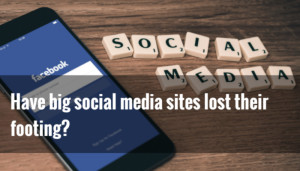 It’s been an interesting couple of days in the world of social media. While the sky is not falling just yet, the sands are definitely shifting and affecting some of the largest social media platforms out there.
It’s been an interesting couple of days in the world of social media. While the sky is not falling just yet, the sands are definitely shifting and affecting some of the largest social media platforms out there.
The way people use Facebook is changing. There are many of reasons for this including the proliferation of new social media platforms, fatigue, and changes in preference among younger demographics particularly.
AdWeek published an article this week with several digital marketing stats. Among them:
- Facebook users are becoming lurkers. A new GlobalWebIndex report said 34 percent of Facebook users posted a status update during the third quarter—meaning 66 percent didn’t post one at all during a three-month period. That’s down from 50 percent of users updating their Facebook statuses during the same period the year before.
- The same GlobalWebIndex study found that while Facebook users were using an average of 2.5 social networks in 2012, that number has since increased to 4.3.
Don’t count Facebook out yet. But, it certainly will have to contend with some challenges in the coming years. B2B marketers have always struggled with how or if to engage on Facebook and these trends don’t make that challenge any easier.
Twitter released its Q3 2015 earnings and, no surprise, the results were underwhelming. A Forbes article relates several takeaways from their earnings report, most notably:
- Twitter continues to struggle in attracting and retaining new users to its platform, and its advertising business is facing challenges with respect to direct-response advertising. In addition, while ad engagement and videos have recently snowballed on the platform, the average cost per ad engagement continues to decline substantially.
The company is making many changes in a bid to improve is performance including new management, platform changes designed to increase engagement, and a dedication to video delivery including Periscope.
As a B2B marketer, I’ve always thought of Twitter as occupying the space somewhere between Facebook and LinkedIn. It clearly has a large base of people using it for personal/B2C exchanges, but it also has a distinct user group that relies on it for B2B communication.
I think the new changes will benefit B2B marketing generally, but whether or not the engagement level will reach a point that can sustain the platform long-term is still in question.
LinkedIn is prized by B2B marketing professionals because it offers a social media platform where you can make business connections in a professional context.
No one can question that LinkedIn is growing and appears to be doing well.
My concern with LinkedIn is the rising number of posts and articles I see raising dissatisfaction with everything from their interface and apps to how they seem to make arbitrary decisions around functionality.
At this point, there is no other platform that serves the purpose that LinkedIn does anywhere close to the level that they do. I just hope that their ears are open and that, while they continue to innovate, they also continue to pay attention to the basic needs and requirements of their users.
Of course, there are many other social media platforms out there. But the fate of these big three will certainly be something that everyone in the marketing profession will keep a close eye on.